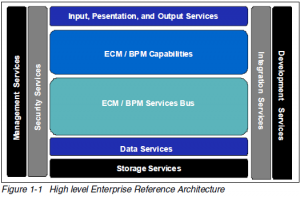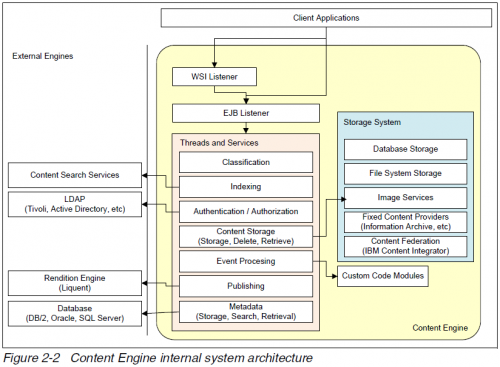IBM Filenet P8 Platform and Architecture: Difference between revisions
No edit summary |
|||
| (24 intermediate revisions by the same user not shown) | |||
| Line 1: | Line 1: | ||
== Core component architecture == | |||
IBM FileNet P8 Platform is the unified enterprise foundation for the integrated IBM FileNet P8 products. | |||
This chapter describes the core components of IBM FileNet P8 Platform, their architecture, data model, and associated security features. | |||
[[File:IBM FileNet - High level Enterprise Reference Architecture.PNG|300px|right|Enterprise Reference Architecture]] | |||
=== Core components overview === | |||
IBM FileNet P8 Platform is a collection of tightly integrated components that are bundled together under a common platform. The broad functionality provided by these integrated components constitute an enterprise content and process management platform. Some of the key elements of this platform are a metadata repository, a process management repository, an out-of-the-box user interface for accessing content and process elements, and a storage framework that can support a wide range of storage devices and platforms. | IBM FileNet P8 Platform is a collection of tightly integrated components that are bundled together under a common platform. The broad functionality provided by these integrated components constitute an enterprise content and process management platform. Some of the key elements of this platform are a metadata repository, a process management repository, an out-of-the-box user interface for accessing content and process elements, and a storage framework that can support a wide range of storage devices and platforms. | ||
To provide these services, the IBM FileNet P8 Platform relies on three core components: | To provide these services, the IBM FileNet P8 Platform relies on three core components: | ||
* Content Engine (CE) | |||
* Process Engine (PE) | |||
* Workplace (WP) / Workplace XT (WP XT) | |||
Figure 2-1 provides a high-level architectural view of these key components and | |||
their relative interactions. | |||
[[File:IBM Filenet - core components.PNG|500px|caption|IBM Filenet Core components]] | |||
=== Content Engine === | |||
The Content Engine stores and retrieves all content within an IBM FileNet P8 system. It provides a series of services for creating, retrieving, updating, deleting, and securing content. In addition, it provides interfaces for handling event-based actions, document life cycle, and integration with various storage mediums. The Content Engine is a J2EE Enterprise Java Bean (EJB) application and is deployed to a supported J2EE application server. The IBM FileNet P8 Platform currently supports a variety of Java application servers, such as IBM WebSphere®. For the complete list of supported application servers, see the | |||
Hardware and Software requirements guide. The Content Engine application is written based on a generic set of J2EE services and is implemented primarily as a set of stateless session beans that take advantage of JDBC to store the metadata in the underlying database. The Content Engine also leverages both native and API-based interfaces to store content in a variety of storage medium. These J2EE services are fronted by two stateless EJBs that make up the EJB Listener, which demarcates the transaction and authentication boundaries into the server. Various asynchronous activities within the server are managed by a series of background threads. Application Engine and Workplace naming convention: Application Engine is the official name for Workplace. Application Engine does not equate to Workplace XT. Both Workplace and Workplace XT support a common set of functions but differ in other areas. For consistency of the terminology used in the book, we use Workplace instead of Application Engine throughout the book. | |||
Figure 2-2 shows the internal system architecture of a Content Engine. | |||
[[File:IBM FileNet - Content Engine internal system architecture.PNG|500px|left|Content Engine internal system architecture]] | |||
=== Concepts === | |||
'''Classes''' Within the Content Engine, each object is defined as an installce of a ''class''. | |||
'''Custom objects''' are metadata-only objects with no associated content elements and are not versionable. Custom objects are typically thought of as a collection of metadata and possibly links to other objects within the Filenet repository. | |||
'''Documents''' The Content Engine allows for storing content as document objects. | |||
'''Foldering''' Content Engine offers a folder and foldering mechanism for organizing content by related iitems into a file system-like structure. | |||
=== Abbrevations === | |||
CBR Content Based Retrieval | |||
CE Content Engine | |||
CSS Content Search Services | |||
Latest revision as of 09:37, 5 April 2018
Core component architecture
IBM FileNet P8 Platform is the unified enterprise foundation for the integrated IBM FileNet P8 products. This chapter describes the core components of IBM FileNet P8 Platform, their architecture, data model, and associated security features.
Core components overview
IBM FileNet P8 Platform is a collection of tightly integrated components that are bundled together under a common platform. The broad functionality provided by these integrated components constitute an enterprise content and process management platform. Some of the key elements of this platform are a metadata repository, a process management repository, an out-of-the-box user interface for accessing content and process elements, and a storage framework that can support a wide range of storage devices and platforms.
To provide these services, the IBM FileNet P8 Platform relies on three core components:
- Content Engine (CE)
- Process Engine (PE)
- Workplace (WP) / Workplace XT (WP XT)
Figure 2-1 provides a high-level architectural view of these key components and their relative interactions.
Content Engine
The Content Engine stores and retrieves all content within an IBM FileNet P8 system. It provides a series of services for creating, retrieving, updating, deleting, and securing content. In addition, it provides interfaces for handling event-based actions, document life cycle, and integration with various storage mediums. The Content Engine is a J2EE Enterprise Java Bean (EJB) application and is deployed to a supported J2EE application server. The IBM FileNet P8 Platform currently supports a variety of Java application servers, such as IBM WebSphere®. For the complete list of supported application servers, see the Hardware and Software requirements guide. The Content Engine application is written based on a generic set of J2EE services and is implemented primarily as a set of stateless session beans that take advantage of JDBC to store the metadata in the underlying database. The Content Engine also leverages both native and API-based interfaces to store content in a variety of storage medium. These J2EE services are fronted by two stateless EJBs that make up the EJB Listener, which demarcates the transaction and authentication boundaries into the server. Various asynchronous activities within the server are managed by a series of background threads. Application Engine and Workplace naming convention: Application Engine is the official name for Workplace. Application Engine does not equate to Workplace XT. Both Workplace and Workplace XT support a common set of functions but differ in other areas. For consistency of the terminology used in the book, we use Workplace instead of Application Engine throughout the book.
Figure 2-2 shows the internal system architecture of a Content Engine.
Concepts
Classes Within the Content Engine, each object is defined as an installce of a class.
Custom objects are metadata-only objects with no associated content elements and are not versionable. Custom objects are typically thought of as a collection of metadata and possibly links to other objects within the Filenet repository.
Documents The Content Engine allows for storing content as document objects.
Foldering Content Engine offers a folder and foldering mechanism for organizing content by related iitems into a file system-like structure.
Abbrevations
CBR Content Based Retrieval CE Content Engine CSS Content Search Services


